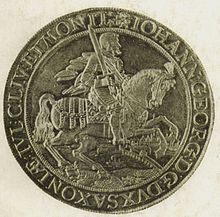- Münzkabinett
-
 Coin of 1628 depicting John George I, Elector of Saxony and the Saxonian coat of arms
Coin of 1628 depicting John George I, Elector of Saxony and the Saxonian coat of arms
The Münzkabinett (English: Coin Cabinet) is part of the Staatliche Kunstsammlungen Dresden (Dresden State Art Collections), Germany. Founded around 1530, it is one of the oldest museums in Dresden. It is located in the Dresden Castle.
The Münzkabinett is among the three largest numismatic collections in Germany. It holds this title with a collection of nearly 300,000 objects, including coins from most countries dating from Antiquity to present day, historic and modern medals, orders and insignia, bank notes and historic bonds, minting dies for coins and medals, seals, models, pre-monetary means of payment, and minting machines and equipment.[1] The Münzkabinett has the status of a Landsmünzkabinett belonging to the State of Saxony, and it is responsible for any hoards of coins found on Saxon territory.
The Münzkabinett is also a center of scholarly research and has a library, open to the public, containing approximately 30,000 volumes.
Contents
History
The Münzkabinett is one of Dresden’s oldest museums with a history going back to the time of Duke Georg the Bearded (1500–1539).[2] Over the course of the centuries, the collection has expanded due to the constant acquisition of items by the Electors and Kings of Saxony. At the beginning of the 18th century, the Dresden Münzkabinett was already a famous coin collection in Europe. The collection evolved to universal status during much of the Baroque period. Beginning in the second half of the 18th century, the Münzkabinett also developed into an important German center of scholarly research.[2]
The collection was kept in the Dresden Castle until 1743, when it was moved to the Taschenbergpalais. In 1786, it was transferred by Elector Friedrich August III, the son of Augustus II the Strong, along with the library and the collection of antiquities, to the Japanisches Palais. In 1877, the Münzkabinett was moved back to the Dresden Castle. From 1911 until 1945, it was housed in the Chancellery Building near the Stallhof.[2]
At the end of the war in 1945, the collection was confiscated by the Red Army and transported to the Soviet Union. It returned to Dresden in 1958 without the books and magazines which had also been taken. From 1959 until 2002, a selection of coins and medals was on view in the Albertinum.
In the summer of 2002, the Münzkabinett finally moved to its place of origin, the Georgenbau of the Dresden Castle. Until the permanent exhibition is installed in the Dresden Castle in a few years’ time, the collection is holding a series of short term exhibitions in the Hausmannsturm.
Exhibition and library
The Münzkabinett exhibition in the Hausmannsturm (Hausmann Tower) is open from April to October. It shows around 300 outstanding objects, including great rarities and unique items, which represent a cross-section of the various parts of the collection.[1] The objects on display have been selected on account of the artistic quality, material value, significance within cultural history, or by the documentation of restoration work. This small and seasonal exhibition is intended to draw the attention to the much larger permanent exhibition that the Münzkabinett will be installing after the castle's restoration is due to be completed in 2013.
For research work, the collection has a library containing approximately 30,000 volumes at its disposal. The library including its study room (Studiensaal) are open to the public.[1]
See also
List of museums in Saxony
Notes and references
- ^ a b c "Münzkabinett (Coin Cabinet)". Dresden State Art Collections. 2011. http://www.skd.museum/en/museums-institutions/residenzschloss/muenzkabinett/index.html. Retrieved 03 November 2011.
- ^ a b c Paul Arnold, Führer durch die ständige Ausstellung des Münzkabinetts, 2nd ed. Dresden: Staatliche Kunstsammlungen, 1978 (German)
External links
- Münzkabinett Homepage of the Dresden State Art Collections
Coordinates: 51°03′10″N 13°44′13″E / 51.05278°N 13.73694°E
Categories:- Numismatic museums
- Museums in Dresden
Wikimedia Foundation. 2010.
